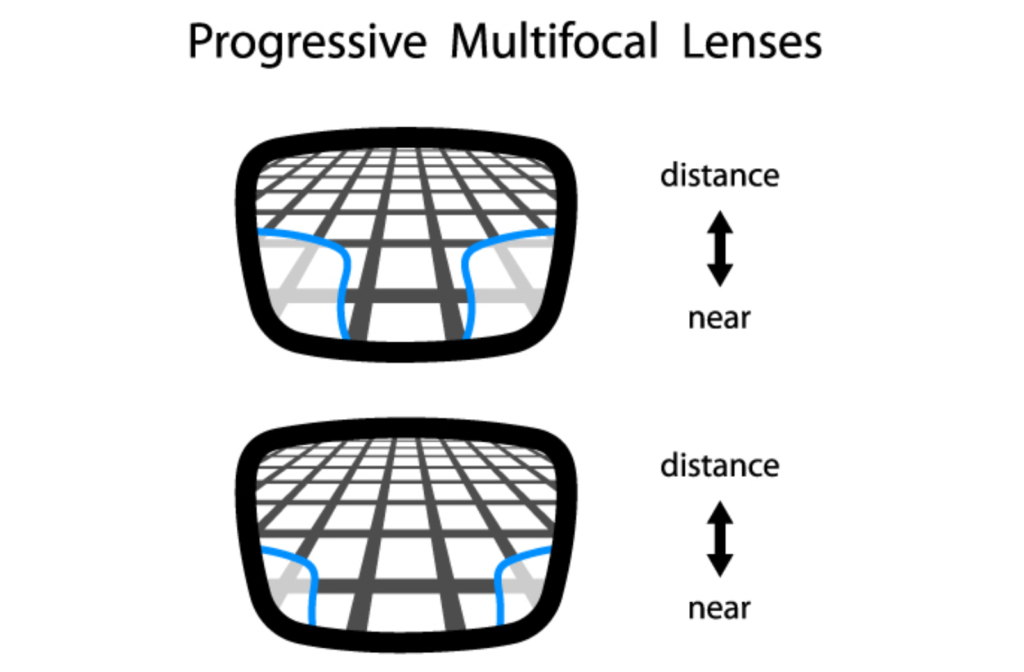Progressive lenses can be an incredible boon to people with astigmatism and other refractive errors, but they also tend to be expensive. Good-quality progressive lenses can cost up to $1200—considerably more than your average pair of standard lenses.
What’s the reason for the price tag on progressive lenses? Moreover, is paying extra for progressive lenses worth it? Don’t worry; the team from Aurora 2020 is prepared to answer these questions and more. We’re happy to share our eyecare experience with you so that you can make an informed choice about the lenses you use.
What Do Progressive Lenses Do?
Progressive lenses differ from traditional ones by allowing you to focus at a variety of distances. Most standard lenses have a single prescription, which only allows the wearer to clearly see when the object they’re looking at is a specific distance away from them.
Some other lenses have surfaces that are broken up into two portions, each with a different prescription. These are called bifocal lenses.
Bifocal lenses usually have one prescription for helping the wearer focus on faraway objects and one for assisting them to focus on nearby items.
Trifocal lenses also exist, in which the surface of each lens is divided into three separate areas with distinct prescriptions. Trifocals and bifocals are both examples of multifocal lenses.
Progressive lenses take a different approach than other multifocal lenses. Instead of breaking up each lens’s surface into distinct areas, progressive lenses have a gradient that allows the prescription to change gradually from top to bottom.
As such, wearing progressive lenses enables you to focus at any distance within the range of your lenses by looking through a different part of them.
Who Are Progressive Lenses For?
Many people can benefit from wearing progressive lenses, but these lenses are particularly useful for correcting a few specific vision problems. Progressive lenses are generally a good investment for people with:
- Presbyopia: an age-related condition caused when the lens inside the eye begins to harden. Presbyopia typically affects people over the age of 40 and makes it difficult for them to focus on nearby objects.
- Accommodative dysfunction: sometimes, people have problems focusing their eyes for reasons that are unrelated to presbyopia. Most types of accommodative dysfunction occur when the muscles that help the eyes focus do not work correctly, causing difficulties when switching or trying to maintain focus.
Progressive lenses may also be a strong choice for people who are unhappy with bifocal or trifocal lenses. Traditional multifocal lenses can jar the wearer’s vision when switching focus at significant distances, which some people find distracting when driving or completing other sensitive tasks. Progressive lenses offer a much smoother transition when viewing objects at different distances.
What Makes Progressive Lenses So Expensive?
One reason progressive lenses cost more than other kinds is that they’re harder to make. Cutting and shaping the gradient on progressive lenses is simply a more delicate and time-consuming process than cutting a lens with the same prescription throughout—or even one with multiple fixed prescriptions.
However, progressive lenses are also more expensive than other lenses because they tend to be much more versatile. Below, we’ll examine how progressive lenses stack up to other multifocal lenses.
Many people also prefer the appearance of progressive lenses. Bifocals and trifocals are split up by lines that run across the lens (1 line for bifocals; 2 for trifocals). These lines can reflect light awkwardly in photographs, and obscure the wearer’s face. Progressive lenses have no lines, giving the lenses a seamless appearance.

High-Quality vs. Low-Quality Progressive Lenses
Not all progressive lenses are the same. Investing in a pair of high-quality progressive lenses can be more expensive than buying cheaper varieties, but it can also provide you with several advantages.
Making the gradient for progressive lenses creates a certain degree of peripheral distortion (sometimes called the “fishbowl effect”). There are 2 main causes of peripheral distortion:
- Too narrow reading/near vision area
- Too short of a drop (the distance between far vision and near vision prescriptions)
Positioning the drop lower down on the lens can reduce peripheral distortion, but it can also make the lenses uncomfortable to use. Cheaper progressive lenses often position the drop too far down the lens, which causes difficulty for the wearer.
Conversely, higher-quality progressive lenses position the drop so that the wearer can look through it naturally, and reduce peripheral distortion by making the viewing area wider.
These changes make the lenses more expensive, but result in far better comfort and vision quality.

Popular Progressive Lens Types
Most progressive lenses fall into one of several categories:
- Standard progressive lenses: these lenses often have a medium-sized reading area, but have a longer drop between focus points. As such, they often require larger frames than premium progressive lenses.
- Short corridor progressive lenses: these alternatives to standard progressive lenses are designed for smaller frames, but they often have smaller reading areas as a result. They produce more peripheral distortion than other progressive lenses.
- Near variable focus lenses: progressive lenses that are designed for indoor applications, like computer use. These lenses usually provide clear vision within a small range of distances and are not intended for focusing on objects that are more than a few feet away from the wearer.
- Premium progressive lenses: brands like Nikon produce progressive lenses with wide reading areas to eliminate peripheral distortion, and are often described as feeling more natural than other types. They can also be tailored to the individual preferences and needs of each person who wears them.
Find Your Ideal Progressive Lenses
If you are considering progressive lenses for yourself or someone in your family, schedule an appointment to speak with your eye doctor. They’ll be able to help you weigh your options and make a recommendation that fits your budget and lifestyle. Once you’ve been fitted for your lenses and spent some time adjusting to them, you’ll enjoy clear vision at an incredible spectrum of distances.



